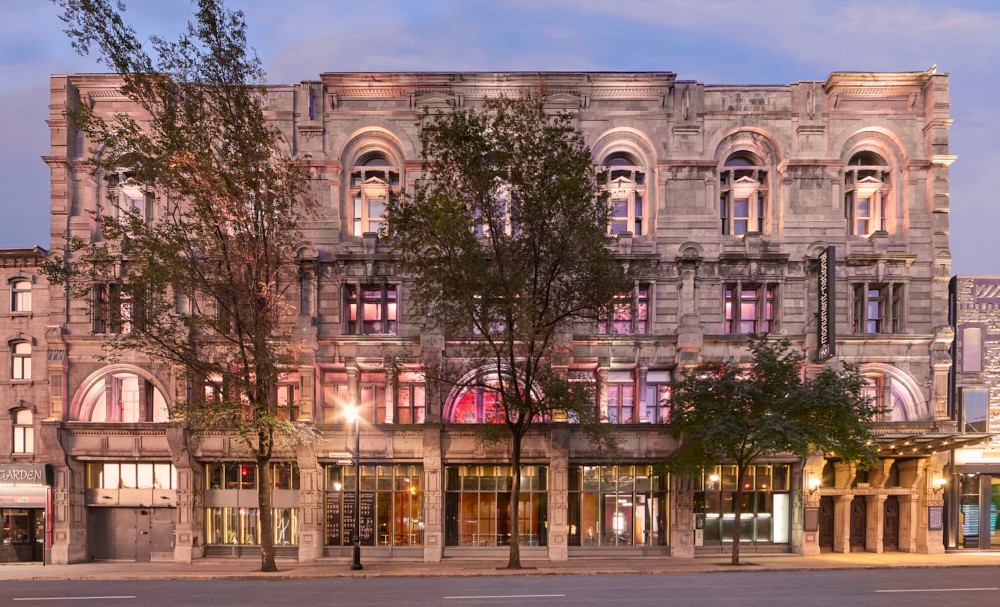The People’s University: The long history of public adult education at the Monument-National
Since 1976 in Quebec and 1985 in Canada, the Monument-National has been classified as a heritage site. Many people today know that this is largely due to its status as the country’s oldest theatre still in operation. However, the Quebec government’s heritage designation reminds us that “Le Monument-National is also of heritage interest for its historical value related to its multifunctional character.” This building is of historic interest not only because of the theatre it houses, but for a multitude of reasons, and this series of articles will attempt to present several of these aspects.
In 1978, the National Theatre School of Canada officially took over ownership of the Monument-National. This new era in the Monument’s history was a continuation of the building’s long history as a theatrical venue, but also of its educational tradition. Conceived as a multifunctional building serving the community, the Monument-National has been a place of learning since its foundation in 1893. In his book Le Monument Inattendu, le Monument-National 1893-1993, Jean-Marc Larrue describes the Monument as “one of the world’s first truly public universities, if not in letter, at least in spirit.” In this article, we look back at this educational tradition to understand the historical roots of teaching at the Monument-National, long before the National Theatre School of Canada.
Education has been central to the Monument-National not only since its opening, but since the very first plans for its construction. As early as the 1880s, the spirit of education was at the heart of the Monument project. It was based on this element of the project that the Quebec government granted a $10,000 subsidy to the Association Saint-Jean Baptiste and enabled it to organize a lottery. It was this same lottery that eventually enabled the Monument project to get back on its feet and finally come to fruition. The educational mission was therefore not happenstance, but rather a central and even vital part of the building’s very existence.
The first classes were held in November 1895, covering both general and technical subjects. The association’s management wanted to serve the community by offering not only training for workers, but also a foundation of education in languages and the humanities, to enable “their elevation by the genius of mind and language.” The list of the first courses offered at the Monument represents the interests of its management: history, agriculture, general mechanics, metallurgy, commerce, architecture, family hygiene and electrical sciences. After a few years, the list of courses expanded to include political economy and marine and navigation.
From their beginnings in 1895, the courses were free for students and made possible mainly by government subsidies. This caused concern for the course directors when their business studies courses became so popular that they inspired the Quebec government to create the École des Hautes Études Commerciales in 1907. However, the subsidy that enabled the Monument’s public classes was maintained, confirming the government’s commitment to the courses and their community objectives.
In addition to public evening classes, the Monument-National’s educational mission was fulfilled as early as 1895 by the Conseil des Arts et Manufactures (later the École des Arts et Métiers), which offered courses in sculpture, sewing, carpentry and drawing (among others). Here we see the forerunner of the painting, set-building and sewing workshops that are still important today at the Monument-National.
Over the years, several courses were added to the Monument’s curriculum to better serve the community: telegraphy and typing courses, English courses for civil servants, French courses for newcomers, tourist guide courses and the École Ménagère Provinciale. 1908 also saw the inauguration of a common law course founded by Marie Guérin Lajoie, who herself took part in the teaching.
Public classes were held until 1955, making the Monument-National one of the first places in Quebec where people could receive free instruction in many essential subjects. According to historian Jean-Marc Larrue, the classes “encouraged and, in some cases, provoked the formation of specialized schools, such as the École des Hautes Études Commerciales, the École technique de Montréal (later the École de Technologie Supérieure), the Institut de Tourisme et d’Hôtellerie du Québec, the École de Marine (now the Institut) and the Conservatoire d’Arts dramatiques.”
Pedagogy remained central to the Monument-National in 1978 when the National Theatre School of Canada took over the premises, which has since been used as the School’s second campus, housing classrooms and a veritable theatre laboratory for its students. Since 2018, the National Theatre School has also been offering public evening classes in the Monument-National tradition. These courses are attended by around 1,000 people a year, who receive evening training in various fields related to theatre and the arts.
The Monument’s original project, as conceived in the 1880s, continues to this day, not only in its theatrical capacity, but also in its educational mission. This has always been central to the Monument-National’s project and remains so now that the building is a campus of the National Theatre School of Canada.
Several sources were consulted for this article, but most of the information comes from the book Le Monument Inattendu, Le Monument-National 1893-1993 by Jean-Marc Larrue, which is the definitive work on the history of the Monument-National.
Figure 1: 1929, École ménagère. Photographe : Rodolphe Carrière. BAnQ, Centre d’archives de Montréal, Collection Institut Notre-Dame du Bon-Conseil de Montréal, P783, S3.
Figure 2: Cours gratuits du soir du Conseil des arts et manufactures salle du cours de coupe et de couture, 1905. BANQ
Figure 3: Cours gratuits du soir du Conseil des arts et manufactures le cours de modelage, 1905. BANQ








Comments